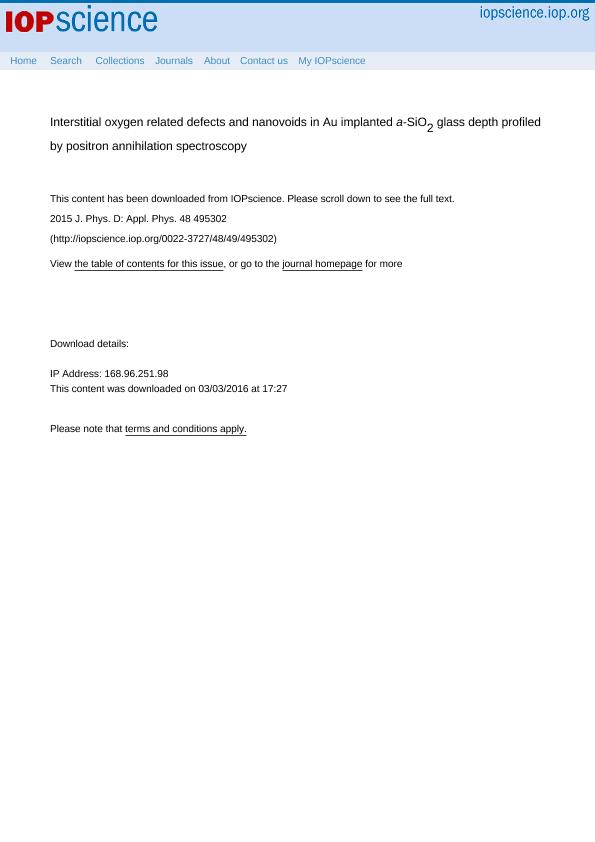Artículo
Interstitial oxygen related defects and nanovoids in Au implanted a-SiO2 glass depth profiled by positron annihilation spectroscopy
Ravelli, L.; Macchi, Carlos Eugenio ; Mariazzi, S.; Mazzoldi, P.; Egger, W.; Hugenschmidt, C.; Somoza, Alberto Horacio
; Mariazzi, S.; Mazzoldi, P.; Egger, W.; Hugenschmidt, C.; Somoza, Alberto Horacio ; Brusa, R. S.
; Brusa, R. S.
 ; Mariazzi, S.; Mazzoldi, P.; Egger, W.; Hugenschmidt, C.; Somoza, Alberto Horacio
; Mariazzi, S.; Mazzoldi, P.; Egger, W.; Hugenschmidt, C.; Somoza, Alberto Horacio ; Brusa, R. S.
; Brusa, R. S.
Fecha de publicación:
11/2015
Editorial:
IOP Publishing
Revista:
Journal Of Physics D: Applied Physics
ISSN:
0022-3727
Idioma:
Inglés
Tipo de recurso:
Artículo publicado
Clasificación temática:
Resumen
Samples of amorphous silica were implanted with Au ions at an energy of 190 keV and fluences of 1×1014 ions cm−2and 5×1014 ions cm−2 at room temperature. The damage produced by ion implantation and its evolution with the thermal treatment at 800 °C for one hour in nitrogen atmosphere was depth profiled using three positron annihilation techniques: Doppler broadening spectroscopy, positron annihilation lifetime spectroscopy and coincidence Doppler broadening spectroscopy. Around the ion projected range of Rp = 67 nm, a size reduction of the silica matrix intrinsic nanovoids points out a local densification ofthe material. Oxygen related defects were found to be present at depths four times the ion projected range, showing a high mobility of oxygen molecules from the densified and stressed region towards the bulk. The 800 °C thermal treatment leads to a recovery of the silica intrinsic nanovoids only in the deeper damaged region and the defect distribution, probed by positrons, shrinks around the ion projected range where the Au atoms aggregate. Open volume defects at the interface between Au and the amorphous matrix were evidenced in both the asimplanted and in the thermal treated samples. A practically complete disappearance of the intrinsic nanovoids was observed around Rp when the implantation fluence was increased by two orders of magnitude (3×1016 ions cm−2). In this case, the oxygen defects move to a depth five times larger than Rp.
Palabras clave:
Glass
,
Amorphous Sio2
,
Au Implantation
,
Positrons
,
Positronium
,
Nanovoids
Archivos asociados
Licencia
Identificadores
Colecciones
Articulos(CCT - LA PLATA)
Articulos de CTRO.CIENTIFICO TECNOL.CONICET - LA PLATA
Articulos de CTRO.CIENTIFICO TECNOL.CONICET - LA PLATA
Articulos(CCT - TANDIL)
Articulos de CTRO CIENTIFICO TECNOLOGICO CONICET - TANDIL
Articulos de CTRO CIENTIFICO TECNOLOGICO CONICET - TANDIL
Articulos(CIFICEN)
Articulos de CENTRO DE INV. EN FISICA E INGENIERIA DEL CENTRO DE LA PCIA. DE BS. AS.
Articulos de CENTRO DE INV. EN FISICA E INGENIERIA DEL CENTRO DE LA PCIA. DE BS. AS.
Citación
Ravelli, L.; Macchi, Carlos Eugenio; Mariazzi, S.; Mazzoldi, P.; Egger, W.; et al.; Interstitial oxygen related defects and nanovoids in Au implanted a-SiO2 glass depth profiled by positron annihilation spectroscopy; IOP Publishing; Journal Of Physics D: Applied Physics; 48; 49; 11-2015; 495302-495302
Compartir
Altmétricas



